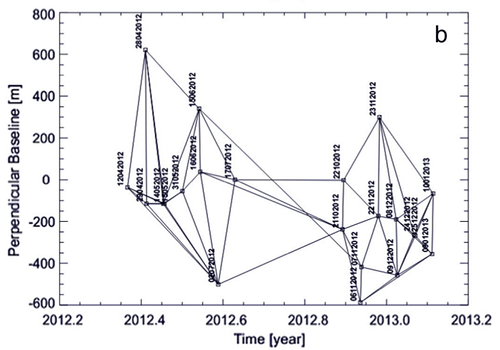Thank you, no problem
Is there a chance to make interferograms out of slave products in a stack?
I made a stack with 1 master and 12 slaves and then made image pairs
master-slave1
slave1-slave2
slave2-slave3
…
But the interferogram operator doesn’t work for the slave-pairs, it generates no output. I tried to rename one of them mst istead of slv08 for instance but this also didn’t bring any change.
I would like to make interferograms of short temporal baselines which are are alreay in the same geometry.
This is something that SNAP does not yet support, but it is a high-priority development in the near future. @mfitrzyk
that would be very nice.
So there is also no workaround at the moment? I tried to split the stack and then stack image pairs manually but they don’t seem to be recognized as an input for the interferogram generation after that.
Is there a way to select an ideal master of many Sentinel-1 SLC scenes for a (one master) stack? The Coregistration overview does only work for non-TOPS products and I would like to select the one with suitable baseline conditions to all other scenes.
Edit: Nevermind - the InSAR stack overview does it. If someone knows a tool which computes the baseline graph as well, I’m interested 
@ABraun what do you mean with “baseline graph”?
yes, that would be nice. Or at least some way to export the table from the stack overview.
Well, I don’t know if it’s the right place but in general, It would be a good SNAP QoL improvement to have a button “copy to clipboard” for any displayed data/tables
That’s an excellent idea!
I realize I’m jumping in on a thread that might be stale, but what @ABraun describes regarding pairing slaves to form interferograms is exactly what I need at the moment. Is there a timeline for such a capability?
Thanks for any advice, in general, I’m grateful for what SNAP provides.
Hi ABraun,
I’m trying to average interferograms, creating according to “Create a DEM using Sentinel-1 Data” reciepe. So, as far as I understand, you’ve stacked unwrapped interferograms after snaphu import. Which tool have you used? Radar - Coregistration - Stack Tools - Create Stack doesn’t work because of “Phase band should not be selected for co-registration” error.
I’m not sure if averaging them before unwrappng might make more sense because the fringes are still present and could be pronounced by the averaging. But I don’t know if snaphu takes anything besides the exported interferogram.
I’m following these steps for a series of S1 SLC IW data (M-S1, M-S2 and so on)
And then I want to do:
Is it a right way to create interferograms stack or may be I missing something?
give it a try!
That’s what my question about. I can’t create stack from imported unwrapped interferograms. I use “Create stack” from Radar - Coregistration - Stack Tools, but receive a mesage “Phase band should not be selected for co-registration” error. What tool did you use for interferograms stacking?
just look above  Interferogram averaging for DEM generation
Interferogram averaging for DEM generation
coregister all images to one master and then stack them with coregistration > create stack.
Ok, I’ve tested this approach, but have been dissapointed by results. So, I’ve come to conclusion, that averaging unwraped interferograms has as little sense, as averaging resulting DEM.
I’d like to ask you again after long time, did you get any result in this topic?
No. I found that areas with suitable coherence area already fine with one pair while areas of low coherence can only hardly be improved by including multiple interferograms. But I am still interested in this point. Any suggestions for a suitable study area? Should contain various surface types and be small enough to be included within one subswath for a first try.

